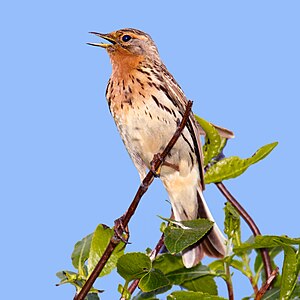European red-throated pipit
| European red-throated pipit | ||||||||||||
|---|---|---|---|---|---|---|---|---|---|---|---|---|

European red-throated pipit ( Anthus cervinus ) |
||||||||||||
| Systematics | ||||||||||||
|
||||||||||||
| Scientific name | ||||||||||||
| Anthus cervinus | ||||||||||||
| ( Pallas , 1811) |
The red-throated pipit ( Anthus cervinus ) is a species of bird in the family of stilts and pipiters . The species inhabits the northern taiga and strauchtundra in Eurasia and Alaska and winters in the tropics of Africa and Asia. In Central Europe, the species is regular migrants in small numbers.
features
The red-throated pipit has a body length of 14 to 15 cm and is thus about as large as the native meadow pipit . The basic color of the top is dull brown. For this reason, the top of the head and the upper back are strongly darkly striated lengthways, the rump is darkly dashed. Adult birds are unmistakable in all their clothes because of the rust-colored throat, with some birds this red markings are also extended to the chest and the sides of the head. The red color of the throat is retained even in the plain dress . The rest of the underside is light yellowish white, the chest and flanks are dashed in black. In young birds in the first winter, the throat is also white. However , these young birds can be distinguished from other beepers by a mostly strong white over-eye stripe, a narrow white eye ring, light umbrella feather edges and whitish back stripes.
Vocalizations
The singing is performed mainly from a singing flight, less often and then shorter from the ground or from waiting. It consists of an initial sequence of sounds that is reminiscent of the song of the tree pipit, followed by trilling or rattling tones and often a rasping sound at the end. The singing can be reproduced like "tsiwi-tsiwi-tsiwi-tsiwi-wiss-wiss-wiss-twiss-wiss-wiss-tsirr" . Migrants often call out "psieh" or "tssiiee" at first sharply and then stretched backwards . The flight call is a soft "Tschüp" .
distribution and habitat
The distribution area of the red-throated pipit includes the northern taiga and the Strauchtundra in Eurasia from Scandinavia to the Chukchi Peninsula and also the west coast of Alaska . It mainly inhabits open swampy lowlands with hardwood bushes, in the taiga also open bogs . On the passage the species is observed in tree-free and mostly moist terrain, e.g. B. on loosely overgrown muddy areas or on moist short-grass areas, but also on drier fallow land, stubble fields or recultivation areas , especially if there are at least individual ponds.
Reproduction
The nest is created on the ground in the vegetation. The eggs are laid at the earliest in late May to early June. The clutch consists of 4 to 7, usually 5 to 6 eggs. The breeding season lasts 10 to 13 days. The incubation is carried out exclusively by the female, who is fed by the male during this time. The young birds fledge after 9 to 14 days.
hikes
The withdrawal from the breeding areas takes place in August to mid-September. The birds in the east of the range overwinter in the tropics of Southeast Asia, the west Palearctic birds in Egypt and especially south of the Sahara in the Sahel and savannahs . The species is regularly observed as a migrant in small numbers in most regions of Central and Eastern Europe. The migration on the move takes place from August to the beginning of November, most of the evidence is available from the end of September to mid-October. The return home through Central Europe takes place in April and May, the breeding areas are reached in mid to late May, at the latest in mid June.
Existence and endangerment
There is no reliable information on the world population ; the IUCN gives a rough estimate of 0.5 to 5.0 million individuals. The species is not endangered according to the IUCN.
literature
- Lars Svensson , Peter J. Grant, Killian Mullarney, Dan Zetterström: The new cosmos bird guide. Kosmos, Stuttgart 1999, ISBN 3-440-07720-9 , p. 250 f.
- Einhard Bezzel: Compendium of the birds of Central Europe. Passeres - songbirds . Aula, Wiesbaden, 1993: pp. 91-95. ISBN 3-89104-530-1
Web links
- Anthus cervinus in the endangered Red List species the IUCN 2008. Posted by: BirdLife International, 2008. Accessed October 13 of 2008.
- Videos, photos and sound recordings on Anthus cervinus in the Internet Bird Collection
- Red-throated pipit feathers
